Road Tests 2012 Ford Mustang Boss 302 + More : )
#1
Hi Member's,
Posting the below article so you know what's out there on the highways with you...Post your thoughts about the `BOSS

<CUFON style="WIDTH: 62px; HEIGHT: 22px" class="cufon cufon-canvas" alt="Road "><CANVAS style="WIDTH: 86px; HEIGHT: 23px; TOP: 0px; LEFT: -2px" width="86" height="23"></CANVAS><CUFONTEXT>Road </CUFONTEXT></CUFON><CUFON style="WIDTH: 57px; HEIGHT: 22px" class="cufon cufon-canvas" alt="Tests"><CANVAS style="WIDTH: 73px; HEIGHT: 23px; TOP: 0px; LEFT: -2px" width="73" height="23"></CANVAS><CUFONTEXT>Tests from MotorWeek</CUFONTEXT></CUFON>
2012 Ford Mustang Boss 302
Vital Statistics
Engine: 5.0-liter V8
Horsepower: 444
Torque: 380 lb-ft
0-60 mph: 4.4 seconds
1/4 mile: 12.4 seconds @124 mph
EPA: 17 mpg city/ 26 mpg highway
Mixed Loop: 19 mpg
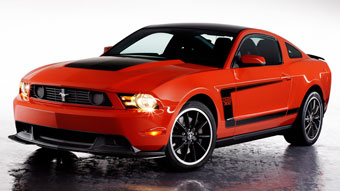
Ford Mustang fans are well aware of the Mustang BOSS 302 and what it accomplished when it first thundered on the scene back in 1969. With the help of former GM designer Larry Shinoda, The BOSS 302 was conceived for one purpose: to beat the Chevrolet Camaro in the SCCAís Trans-Am series. The BOSS 302 name actually came from the engine, a special High Output version of the then, still new 5.0-liter V8. Well, now that the 5-POINT-0 is back in the Mustang lineup, it seems only fitting that a BOSS 302 make a roaring return as well.
And roar it does! Well, weíre not sure a horse can actually roar, but neighing just sounds lame, and the 2012 Ford Mustang BOSS 302 does not sound lame! Letting 444 horses run wild on a drag strip results in a thunderous roar that we wonít soon forget. Needless to say, we loved every foot of asphalt we conquered in this very special Mustang.
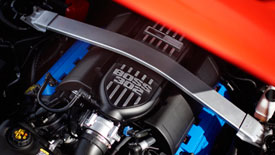 So, what makes the new BOSS 302, a boss? Well obviously, it starts under the hood with the Mustang GTís familiar 5.0-liter or 302 cubic inch V8. Now add new heads and intake manifold feeding larger valves, more aggressive camshafts, combined with Fordís Twin independent Variable Camshaft Timing, and you get a bump of 32 horsepower to the magic 444. But there is a small penalty as torque falls by 10 to 380 lb-ft. The clutch also gets beefed up, to more surely send power to the limited-slip 3.73 rear through a six speed transmission with one of the best shifters weíve ever put our hands on. Everything about the BOSS works together just right; the way it responds, the stance, even the sound is loud when you want it to be and quiet when you donít, thanks to a new quad exhaust system with both rear and side outlets. And it looks cool, too.
So, what makes the new BOSS 302, a boss? Well obviously, it starts under the hood with the Mustang GTís familiar 5.0-liter or 302 cubic inch V8. Now add new heads and intake manifold feeding larger valves, more aggressive camshafts, combined with Fordís Twin independent Variable Camshaft Timing, and you get a bump of 32 horsepower to the magic 444. But there is a small penalty as torque falls by 10 to 380 lb-ft. The clutch also gets beefed up, to more surely send power to the limited-slip 3.73 rear through a six speed transmission with one of the best shifters weíve ever put our hands on. Everything about the BOSS works together just right; the way it responds, the stance, even the sound is loud when you want it to be and quiet when you donít, thanks to a new quad exhaust system with both rear and side outlets. And it looks cool, too.
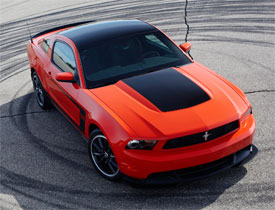 From its old school side stripes, to the black, power bulge hood, the look is total nostalgia. Our cars blacked out roof panel and Competition Orange paint job only added to the BOSS 302 heritage inspired look. From dead on, the look is more modern, but also very mean, with a large blacked-out grill, with blocked off fog lights and a lower apron with attached splitter. Out back thereís a rear spoiler and black tail panel between the vertical tail lights with sequential turn signals. The BOSS rides on black 19-inch wheels wearing 255/40 Pirelli PZeroís up front, and 285/35ís in the rear.
From its old school side stripes, to the black, power bulge hood, the look is total nostalgia. Our cars blacked out roof panel and Competition Orange paint job only added to the BOSS 302 heritage inspired look. From dead on, the look is more modern, but also very mean, with a large blacked-out grill, with blocked off fog lights and a lower apron with attached splitter. Out back thereís a rear spoiler and black tail panel between the vertical tail lights with sequential turn signals. The BOSS rides on black 19-inch wheels wearing 255/40 Pirelli PZeroís up front, and 285/35ís in the rear.
In the driverís seat, you certainly feel like the boss, as tooling around town youíd think you were driving a Ferrari by all of the looks and thumbs up that you get. And while cool, nostalgic muscle-car styling is all well-and-good, eventually you have to back that up, and to see what the BOSS is really capable of.
At our 75-80 home track, the BOSS quickly went to work with a 4.4-second trip to 60. Thatís 3-tenths faster than the last Mustang GT we tested. It was all business as usual down the quarter mile, as well, tripping the clock at 12.4-seconds at 124 miles-per-hour. As much as we love 60ís muscle cars, this new BOSS kicks the old BOSSí tail. Itís not hard to imagine that the new BOSS would also be a much better handler, and indeed it shot through our slalom course like a downhill skier on a gold-medal run. The GTís suspension has been totally reworked with adjustable shocks and struts. Standard, too, is electronically adjustable steering, with settings for Comfort, Standard, and Sport. Braking tasks are handled by oversized ABS equipped discs at all four wheels and brought the BOSS to a halt in just 111 feet. So, itís short work!
Inside, the BOSS is a definite promotion over the Mustang GTís generally well thought out interior. An Alcantara steering wheel is standard while SVT-design Recaro seats are an awesome upgrade that we recommend. They let you feel fastened to the car while being surprisingly comfortable. Rear seating is still pony car tight however, but the seat back does fold to increase the 13.4 cubic-feet of cargo space.
Government Fuel Economy Ratings for the Ford Mustang BOSS 302 are 17-City and 26-Highway. After driving it like it was meant to be driven, we averaged 19 miles-per-gallon of regular. The Energy Impact Score is a fairly reasonable 17.1 barrels of oil consumed per year with a Carbon Footprint of 9.3 annual tons of CO2 emitted. And fortunately, you donít have to be a big boss to afford the BOSS, as it comes in at $40,995. While thatís not cheap, you get a lot of car for the money, and a real performance bargain.
But even more than the performance, that money buys a look that screams nostalgia, but with a contemporary edge and an interior filled with modern conveniences. So, as much as weíd love to take a ride in a í69 BOSS 302, weíre pretty happy with the 2012 BOSS, and think anybody looking to work with some serious muscle will be, too.
Posting the below article so you know what's out there on the highways with you...Post your thoughts about the `BOSS


<CUFON style="WIDTH: 62px; HEIGHT: 22px" class="cufon cufon-canvas" alt="Road "><CANVAS style="WIDTH: 86px; HEIGHT: 23px; TOP: 0px; LEFT: -2px" width="86" height="23"></CANVAS><CUFONTEXT>Road </CUFONTEXT></CUFON><CUFON style="WIDTH: 57px; HEIGHT: 22px" class="cufon cufon-canvas" alt="Tests"><CANVAS style="WIDTH: 73px; HEIGHT: 23px; TOP: 0px; LEFT: -2px" width="73" height="23"></CANVAS><CUFONTEXT>Tests from MotorWeek</CUFONTEXT></CUFON>
2012 Ford Mustang Boss 302
Vital Statistics
Engine: 5.0-liter V8
Horsepower: 444
Torque: 380 lb-ft
0-60 mph: 4.4 seconds
1/4 mile: 12.4 seconds @124 mph
EPA: 17 mpg city/ 26 mpg highway
Mixed Loop: 19 mpg

Ford Mustang fans are well aware of the Mustang BOSS 302 and what it accomplished when it first thundered on the scene back in 1969. With the help of former GM designer Larry Shinoda, The BOSS 302 was conceived for one purpose: to beat the Chevrolet Camaro in the SCCAís Trans-Am series. The BOSS 302 name actually came from the engine, a special High Output version of the then, still new 5.0-liter V8. Well, now that the 5-POINT-0 is back in the Mustang lineup, it seems only fitting that a BOSS 302 make a roaring return as well.
And roar it does! Well, weíre not sure a horse can actually roar, but neighing just sounds lame, and the 2012 Ford Mustang BOSS 302 does not sound lame! Letting 444 horses run wild on a drag strip results in a thunderous roar that we wonít soon forget. Needless to say, we loved every foot of asphalt we conquered in this very special Mustang.
 So, what makes the new BOSS 302, a boss? Well obviously, it starts under the hood with the Mustang GTís familiar 5.0-liter or 302 cubic inch V8. Now add new heads and intake manifold feeding larger valves, more aggressive camshafts, combined with Fordís Twin independent Variable Camshaft Timing, and you get a bump of 32 horsepower to the magic 444. But there is a small penalty as torque falls by 10 to 380 lb-ft. The clutch also gets beefed up, to more surely send power to the limited-slip 3.73 rear through a six speed transmission with one of the best shifters weíve ever put our hands on. Everything about the BOSS works together just right; the way it responds, the stance, even the sound is loud when you want it to be and quiet when you donít, thanks to a new quad exhaust system with both rear and side outlets. And it looks cool, too.
So, what makes the new BOSS 302, a boss? Well obviously, it starts under the hood with the Mustang GTís familiar 5.0-liter or 302 cubic inch V8. Now add new heads and intake manifold feeding larger valves, more aggressive camshafts, combined with Fordís Twin independent Variable Camshaft Timing, and you get a bump of 32 horsepower to the magic 444. But there is a small penalty as torque falls by 10 to 380 lb-ft. The clutch also gets beefed up, to more surely send power to the limited-slip 3.73 rear through a six speed transmission with one of the best shifters weíve ever put our hands on. Everything about the BOSS works together just right; the way it responds, the stance, even the sound is loud when you want it to be and quiet when you donít, thanks to a new quad exhaust system with both rear and side outlets. And it looks cool, too.  From its old school side stripes, to the black, power bulge hood, the look is total nostalgia. Our cars blacked out roof panel and Competition Orange paint job only added to the BOSS 302 heritage inspired look. From dead on, the look is more modern, but also very mean, with a large blacked-out grill, with blocked off fog lights and a lower apron with attached splitter. Out back thereís a rear spoiler and black tail panel between the vertical tail lights with sequential turn signals. The BOSS rides on black 19-inch wheels wearing 255/40 Pirelli PZeroís up front, and 285/35ís in the rear.
From its old school side stripes, to the black, power bulge hood, the look is total nostalgia. Our cars blacked out roof panel and Competition Orange paint job only added to the BOSS 302 heritage inspired look. From dead on, the look is more modern, but also very mean, with a large blacked-out grill, with blocked off fog lights and a lower apron with attached splitter. Out back thereís a rear spoiler and black tail panel between the vertical tail lights with sequential turn signals. The BOSS rides on black 19-inch wheels wearing 255/40 Pirelli PZeroís up front, and 285/35ís in the rear. In the driverís seat, you certainly feel like the boss, as tooling around town youíd think you were driving a Ferrari by all of the looks and thumbs up that you get. And while cool, nostalgic muscle-car styling is all well-and-good, eventually you have to back that up, and to see what the BOSS is really capable of.
At our 75-80 home track, the BOSS quickly went to work with a 4.4-second trip to 60. Thatís 3-tenths faster than the last Mustang GT we tested. It was all business as usual down the quarter mile, as well, tripping the clock at 12.4-seconds at 124 miles-per-hour. As much as we love 60ís muscle cars, this new BOSS kicks the old BOSSí tail. Itís not hard to imagine that the new BOSS would also be a much better handler, and indeed it shot through our slalom course like a downhill skier on a gold-medal run. The GTís suspension has been totally reworked with adjustable shocks and struts. Standard, too, is electronically adjustable steering, with settings for Comfort, Standard, and Sport. Braking tasks are handled by oversized ABS equipped discs at all four wheels and brought the BOSS to a halt in just 111 feet. So, itís short work!
Inside, the BOSS is a definite promotion over the Mustang GTís generally well thought out interior. An Alcantara steering wheel is standard while SVT-design Recaro seats are an awesome upgrade that we recommend. They let you feel fastened to the car while being surprisingly comfortable. Rear seating is still pony car tight however, but the seat back does fold to increase the 13.4 cubic-feet of cargo space.
Government Fuel Economy Ratings for the Ford Mustang BOSS 302 are 17-City and 26-Highway. After driving it like it was meant to be driven, we averaged 19 miles-per-gallon of regular. The Energy Impact Score is a fairly reasonable 17.1 barrels of oil consumed per year with a Carbon Footprint of 9.3 annual tons of CO2 emitted. And fortunately, you donít have to be a big boss to afford the BOSS, as it comes in at $40,995. While thatís not cheap, you get a lot of car for the money, and a real performance bargain.
But even more than the performance, that money buys a look that screams nostalgia, but with a contemporary edge and an interior filled with modern conveniences. So, as much as weíd love to take a ride in a í69 BOSS 302, weíre pretty happy with the 2012 BOSS, and think anybody looking to work with some serious muscle will be, too.
Last edited by Space; 09-11-2011 at 09:42 AM.
#2
2011 Lotus Evora S
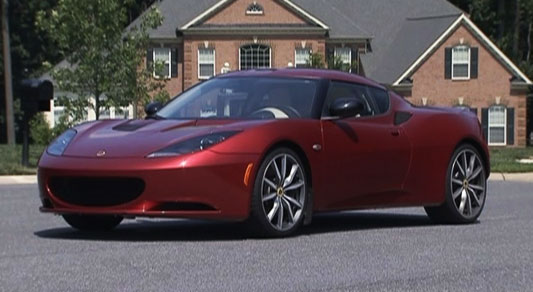
Vital Statistics
Engine: 3.5 liter
Horsepower: 345
Torque: 295 lb-ft
0-60 mph: 4.3 seconds
1/4 mile: 12.8 seconds @ 107 mph
EPA: 17 city/ 26 highway
Mixed Loop: 19.6 mpg
Famed designer Colin Chapman founded Lotus cars with a less is more philosophy that has stood the test of time: all else being equal, a small lightweight chassis will out-perform a heavier car in the long run. Nimble handling, short braking and quick acceleration have been hallmarks of Lotus brand sports cars since the beginning, and the 2011 Evora S hits all those targets dead center. Quickness starts with the addition of a Harrop supercharger to the Evora’s already highly modified, mid-mounted Toyota v6. Compared to the Evora we tested last spring, horsepower jumps 69 to 345, while torque rises to 295 pound-feet, a gain of 37.
The chassis tub - made of extruded aluminum that’s bonded rather than welded - weighs just 440 pounds, including the front and rear subframes. The S adds stiffer bushings, a new front upper suspension for increased castor, and revised damping. Curb weight is a scant 3,168 pounds, and doing the math — that’s just 9.2 pounds per horsepower. Pushing the sport button activates an exhaust bypass valve, raises the redline to 7200 rpm, and improves throttle response. It also alters the stability control system to allow more oversteer in turns. The result? The Evora S driver is not just connected to the road, he or she is hard-wired through the steering.
Our drag strip slalom course has never felt so ho-hum. But, every twisty back road between home and track proved a direct path to nirvana. It’s hard to believe the S improves on the standard Evora’s response, but it does. Ride quality, however, remains impressively good thanks to a long-for-its-size 101.4-inch wheelbase. The S also has a notably faster feel than the standard Evora. Torque hits a sweet spot from 2500 to 4500 rpm. Launches catapult you off the line. But, while new shift cables improve action, long throws and a rubbery feel still impede gear changes. Clutch engagement, however, is perfect as is.
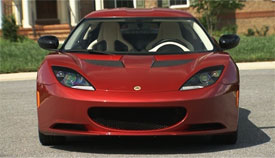 Lotus claims a 4.3-second 0 to 60 time, a number that we couldn’t quite match in test day’s 95 degree heat. But we felt somewhat redeemed by a 12.8-second quarter mile at 107 miles per hour. On a longer straight, this little rocket will top out at a heady 172. Our S wore 19 front, and 20-inch rear Pirelli p-zero corsa tires. Behind them are AP racing four-piston calipers on cross-drilled rotors. They hauled our S quickly to a stop in a scant 105 feet from 60. The only fade was in our drivers as they strained to keep their eyeballs in place!
Lotus claims a 4.3-second 0 to 60 time, a number that we couldn’t quite match in test day’s 95 degree heat. But we felt somewhat redeemed by a 12.8-second quarter mile at 107 miles per hour. On a longer straight, this little rocket will top out at a heady 172. Our S wore 19 front, and 20-inch rear Pirelli p-zero corsa tires. Behind them are AP racing four-piston calipers on cross-drilled rotors. They hauled our S quickly to a stop in a scant 105 feet from 60. The only fade was in our drivers as they strained to keep their eyeballs in place!
Our Evora S came decked out in a darkish red hue, and everything about it says sports car! As we’ve noted before, the Evora’s smoother shape is more mature than the edgier Elise and Exige. From the smiley meshed grill and elongated headlights, to the hood and profile character lines, the fluid motion looks alive. At the back are wide eyed taillights, a wing, center exhaust, and the loud and proud lotus name stretching all the way across the car.
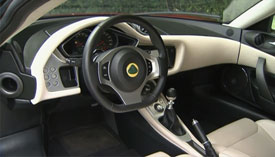 The interior is little changed from before. It’s upscale and business-like and not nearly as tight as it looks. But, eccentric switches and components, plus less than stellar fit and finish, make it seem more kit car than limited production. While the Evora is a 2+2, our car came without the child only rear seat. The package shelf is more useful. Another practical note, government fuel economy ratings for the Evora S are 17 city and 26 highway. Our mixed loop returned a heavy footed 19.6 mpg on premium.
The interior is little changed from before. It’s upscale and business-like and not nearly as tight as it looks. But, eccentric switches and components, plus less than stellar fit and finish, make it seem more kit car than limited production. While the Evora is a 2+2, our car came without the child only rear seat. The package shelf is more useful. Another practical note, government fuel economy ratings for the Evora S are 17 city and 26 highway. Our mixed loop returned a heavy footed 19.6 mpg on premium.
But just how practical is it to own a Lotus Evora S? Reasonably, is our answer. The S stickers for $77,175. That’s not bad for such a rare, stunning to see, and superb to drive machine. Still, we think the Evora’s shortcomings, interior fitment, and a vague shifter, need immediate attention. Cars like the new Audi TT-RS, not to mention Porsche Cayman and 911, excel in those departments.
Lotus cars is to be commended for sticking to their minimalist idealism as the Evora S is overall an exciting mix of nimbleness, performance and exclusivity. But, specialized attention is needed to keep this blossom from wilting. And we can’t wait for Lotus to grow to the challenge.

Vital Statistics
Engine: 3.5 liter
Horsepower: 345
Torque: 295 lb-ft
0-60 mph: 4.3 seconds
1/4 mile: 12.8 seconds @ 107 mph
EPA: 17 city/ 26 highway
Mixed Loop: 19.6 mpg
Famed designer Colin Chapman founded Lotus cars with a less is more philosophy that has stood the test of time: all else being equal, a small lightweight chassis will out-perform a heavier car in the long run. Nimble handling, short braking and quick acceleration have been hallmarks of Lotus brand sports cars since the beginning, and the 2011 Evora S hits all those targets dead center. Quickness starts with the addition of a Harrop supercharger to the Evora’s already highly modified, mid-mounted Toyota v6. Compared to the Evora we tested last spring, horsepower jumps 69 to 345, while torque rises to 295 pound-feet, a gain of 37.
The chassis tub - made of extruded aluminum that’s bonded rather than welded - weighs just 440 pounds, including the front and rear subframes. The S adds stiffer bushings, a new front upper suspension for increased castor, and revised damping. Curb weight is a scant 3,168 pounds, and doing the math — that’s just 9.2 pounds per horsepower. Pushing the sport button activates an exhaust bypass valve, raises the redline to 7200 rpm, and improves throttle response. It also alters the stability control system to allow more oversteer in turns. The result? The Evora S driver is not just connected to the road, he or she is hard-wired through the steering.
Our drag strip slalom course has never felt so ho-hum. But, every twisty back road between home and track proved a direct path to nirvana. It’s hard to believe the S improves on the standard Evora’s response, but it does. Ride quality, however, remains impressively good thanks to a long-for-its-size 101.4-inch wheelbase. The S also has a notably faster feel than the standard Evora. Torque hits a sweet spot from 2500 to 4500 rpm. Launches catapult you off the line. But, while new shift cables improve action, long throws and a rubbery feel still impede gear changes. Clutch engagement, however, is perfect as is.
 Lotus claims a 4.3-second 0 to 60 time, a number that we couldn’t quite match in test day’s 95 degree heat. But we felt somewhat redeemed by a 12.8-second quarter mile at 107 miles per hour. On a longer straight, this little rocket will top out at a heady 172. Our S wore 19 front, and 20-inch rear Pirelli p-zero corsa tires. Behind them are AP racing four-piston calipers on cross-drilled rotors. They hauled our S quickly to a stop in a scant 105 feet from 60. The only fade was in our drivers as they strained to keep their eyeballs in place!
Lotus claims a 4.3-second 0 to 60 time, a number that we couldn’t quite match in test day’s 95 degree heat. But we felt somewhat redeemed by a 12.8-second quarter mile at 107 miles per hour. On a longer straight, this little rocket will top out at a heady 172. Our S wore 19 front, and 20-inch rear Pirelli p-zero corsa tires. Behind them are AP racing four-piston calipers on cross-drilled rotors. They hauled our S quickly to a stop in a scant 105 feet from 60. The only fade was in our drivers as they strained to keep their eyeballs in place!Our Evora S came decked out in a darkish red hue, and everything about it says sports car! As we’ve noted before, the Evora’s smoother shape is more mature than the edgier Elise and Exige. From the smiley meshed grill and elongated headlights, to the hood and profile character lines, the fluid motion looks alive. At the back are wide eyed taillights, a wing, center exhaust, and the loud and proud lotus name stretching all the way across the car.
 The interior is little changed from before. It’s upscale and business-like and not nearly as tight as it looks. But, eccentric switches and components, plus less than stellar fit and finish, make it seem more kit car than limited production. While the Evora is a 2+2, our car came without the child only rear seat. The package shelf is more useful. Another practical note, government fuel economy ratings for the Evora S are 17 city and 26 highway. Our mixed loop returned a heavy footed 19.6 mpg on premium.
The interior is little changed from before. It’s upscale and business-like and not nearly as tight as it looks. But, eccentric switches and components, plus less than stellar fit and finish, make it seem more kit car than limited production. While the Evora is a 2+2, our car came without the child only rear seat. The package shelf is more useful. Another practical note, government fuel economy ratings for the Evora S are 17 city and 26 highway. Our mixed loop returned a heavy footed 19.6 mpg on premium.But just how practical is it to own a Lotus Evora S? Reasonably, is our answer. The S stickers for $77,175. That’s not bad for such a rare, stunning to see, and superb to drive machine. Still, we think the Evora’s shortcomings, interior fitment, and a vague shifter, need immediate attention. Cars like the new Audi TT-RS, not to mention Porsche Cayman and 911, excel in those departments.
Lotus cars is to be commended for sticking to their minimalist idealism as the Evora S is overall an exciting mix of nimbleness, performance and exclusivity. But, specialized attention is needed to keep this blossom from wilting. And we can’t wait for Lotus to grow to the challenge.
#3
2012 Fiat 500c  What ? What member is going 2 get one ? ? ?
What ? What member is going 2 get one ? ? ?
<EMBED height=387 type=application/x-shockwave-flash width=638 src=http://www.youtube.com/v/zkkWIKizxv4?fs=1&hl=en_US&rel=0&hd=1&autoplay=0 allowscriptaccess="always" allowfullscreen="true"><!-- -->
<!-- .clear -->
<!-- .video_player --><!-- -->
<!-- .clear --><!-- -->
<!-- .shadow_left_large --><!-- -->
<!-- .shadow_right_large -->
<!-- .video_player_shadow_holder --><!-- -->
<!-- .clear -->When it went on sale this spring, the Fiat 500 brought a splash of Italian style to the subcompact car market here in the U.S. It also brought good fuel economy and a surprisingly fun driving experience. Well, now it looks to add a little open air motoring to the mix as well, so put down your Gelato and grab your shades, it's time for a drive.
Like an afternoon jolt of caffeine, the 2012 Fiat 500c-for Cabrio-offers a quick pick-me-up for the sleepy subcompact car market. The 500 Cabrio is certainly unlike any other car in the segment, with a fully retracting canvas top that's more like a big sunroof than a true convertible. But, leaving the side pillars and doors intact does have a host of advantages, like structural integrity, and this plus, retaining the curtain airbags.
It makes for an odd look, but one that also turns a lot of heads. The top can be folded in stages, which is good, as all the way down, the top stack blocks the rear view mirror's line of site. Folding it three-fourths of the way still gives you the full open-air experience but leaves the rear view intact.
 Mounted on the top is a plastic spoiler that includes the third brake light, and no matter how far you fold the top, the brake light is visible. Like the Mini Cooper Convertible, the 500 Cabrio trades its hatchback for something akin to a trunk. And under the smaller lid, there's a smaller space. Cargo volume falls from 9.5 to 5.4-cubic feet, which is slightly less than the MINI, but the 500c's rear seats do fold to accommodate longer items.
Mounted on the top is a plastic spoiler that includes the third brake light, and no matter how far you fold the top, the brake light is visible. Like the Mini Cooper Convertible, the 500 Cabrio trades its hatchback for something akin to a trunk. And under the smaller lid, there's a smaller space. Cargo volume falls from 9.5 to 5.4-cubic feet, which is slightly less than the MINI, but the 500c's rear seats do fold to accommodate longer items.
Otherwise, the majority of the exterior remains the same friendly, Euro-chic bulldog that we loved so much in the coupe. But, we'll pass on our car's bodyside decals, which not only look cheesy, they don't quite line-up.
Much like the 500 hardtop, the 500 Cabrio is surprisingly fun to drive. Ride quality is very solid over bumps, and for such a small car it feels quite substantial. With its body-side uppers still intact, cowl shake is not an issue.
And, for the most part the 500c does feel like driving a true convertible, but with reduced side to side visibility. Inside, there's very little wind buffeting as the interior stays calm. Still, it feels most at home in relaxed cruising, and would make the perfect beach car. And, with the canvas top closed, the interior is premium car quiet.
Government Fuel Economy ratings for the 2012 Fiat 500 Cabrio automatic are 27-City and 32-Highway, but we managed to beat those numbers pretty handily with an average of 37 miles-per-gallon of premium. That's also far better than our hardtop manual's test result. The Cabrio's Energy Impact Score is a better than average 11.8 barrels of oil consumed per year, with a Carbon Footprint of 6.5 tons of CO2 emitted annually.
Inside the new Cabrio, not much has changed; the retro-dash mixes body color and black plastics, while our Lounge model adds nice looking brown leather. They're all pleasant elements and everything has a quality feel, even though some of our staff were not crazy about the combination of colors.
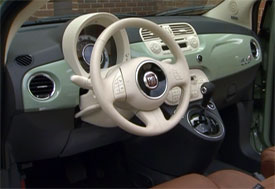 Radio sound comes from BOSE, and despite a vintage look, controls are push button, no *****. We did find some controls throughout the interior a bit confusing at first, and some of our testers complained that the concentric gauges took a bit of getting used to. But in time, we did. The Cabrio retains rear seating for two, but we don't recommend putting any of your friends back there.
Radio sound comes from BOSE, and despite a vintage look, controls are push button, no *****. We did find some controls throughout the interior a bit confusing at first, and some of our testers complained that the concentric gauges took a bit of getting used to. But in time, we did. The Cabrio retains rear seating for two, but we don't recommend putting any of your friends back there.
Under the 500 Cabrio's small hood is the same 1.4-liter engine as the hardtop. The "Multiair" in-line four rates 101-horsepower and only 98 lb-ft. of torque. But, it never felt like it was really working that hard. But work it we did at our test track. The 500c took a leisurely 9.8 seconds to reach 60. And it achieved a quarter mile time of 17.2 seconds at 90 miles-per-hour.
The 6-speed automatic provided fairly quick shifts, and power didn't seem to drop off as much between gears, as in the 5-speed manual Coupe that we tested a few months ago.
Through the cones, our Cabrio Lounge model also had a distinctly different personality than the Coupe Sport model, but still good fun. Despite plenty of roll, you can really hammer through here, and the 500c never gets upset. And as it scoots through without a care, you can't help but smile.
Prices made us smile, too. The 2012 Fiat 500 Cabrio comes in Pop and Lounge trim, but not Sport, with prices starting at $20,000. That's 5-grand less than a MINI Cooper Convertible, and the cheapest 4 seat convertible available.
Inexpensive, stylish, unique, these are all reasons to love the 500 Cabrio, but our favorite reason is that while it has acquired a convertible top, it has retained the fun-to-drive nature that we loved so much in the Coupe. So, Ciao, at least for now, and may we meet again soon!
<A href="http://www.motorweek.org/reviews/road_tests/2012_fiat_500_cabrio#">
<!-- .left -->Vital Statistics
Engine: 1.4-liter
Horsepower: 101
Torque: 98 lb feet
0-60 mph: 9.8 seconds~> Hold ON ~>
1/4 mile: 17.2 seconds @ 90 mph
EPA: 27 mpg city/ 32 mpg highway
Mixed Loop: 37 mpg
Energy Impact: 11.8 barrels oil/yr
CO2 Emissions: 6.5 tons/yr
<!-- .review_box -->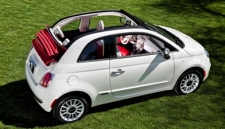
 What ? What member is going 2 get one ? ? ?
What ? What member is going 2 get one ? ? ?<EMBED height=387 type=application/x-shockwave-flash width=638 src=http://www.youtube.com/v/zkkWIKizxv4?fs=1&hl=en_US&rel=0&hd=1&autoplay=0 allowscriptaccess="always" allowfullscreen="true"><!-- -->
<!-- .clear -->
<!-- .video_player --><!-- -->
<!-- .clear --><!-- -->
<!-- .shadow_left_large --><!-- -->
<!-- .shadow_right_large -->
<!-- .video_player_shadow_holder --><!-- -->
<!-- .clear -->When it went on sale this spring, the Fiat 500 brought a splash of Italian style to the subcompact car market here in the U.S. It also brought good fuel economy and a surprisingly fun driving experience. Well, now it looks to add a little open air motoring to the mix as well, so put down your Gelato and grab your shades, it's time for a drive.
Like an afternoon jolt of caffeine, the 2012 Fiat 500c-for Cabrio-offers a quick pick-me-up for the sleepy subcompact car market. The 500 Cabrio is certainly unlike any other car in the segment, with a fully retracting canvas top that's more like a big sunroof than a true convertible. But, leaving the side pillars and doors intact does have a host of advantages, like structural integrity, and this plus, retaining the curtain airbags.
It makes for an odd look, but one that also turns a lot of heads. The top can be folded in stages, which is good, as all the way down, the top stack blocks the rear view mirror's line of site. Folding it three-fourths of the way still gives you the full open-air experience but leaves the rear view intact.
 Mounted on the top is a plastic spoiler that includes the third brake light, and no matter how far you fold the top, the brake light is visible. Like the Mini Cooper Convertible, the 500 Cabrio trades its hatchback for something akin to a trunk. And under the smaller lid, there's a smaller space. Cargo volume falls from 9.5 to 5.4-cubic feet, which is slightly less than the MINI, but the 500c's rear seats do fold to accommodate longer items.
Mounted on the top is a plastic spoiler that includes the third brake light, and no matter how far you fold the top, the brake light is visible. Like the Mini Cooper Convertible, the 500 Cabrio trades its hatchback for something akin to a trunk. And under the smaller lid, there's a smaller space. Cargo volume falls from 9.5 to 5.4-cubic feet, which is slightly less than the MINI, but the 500c's rear seats do fold to accommodate longer items.Otherwise, the majority of the exterior remains the same friendly, Euro-chic bulldog that we loved so much in the coupe. But, we'll pass on our car's bodyside decals, which not only look cheesy, they don't quite line-up.
Much like the 500 hardtop, the 500 Cabrio is surprisingly fun to drive. Ride quality is very solid over bumps, and for such a small car it feels quite substantial. With its body-side uppers still intact, cowl shake is not an issue.
And, for the most part the 500c does feel like driving a true convertible, but with reduced side to side visibility. Inside, there's very little wind buffeting as the interior stays calm. Still, it feels most at home in relaxed cruising, and would make the perfect beach car. And, with the canvas top closed, the interior is premium car quiet.
Government Fuel Economy ratings for the 2012 Fiat 500 Cabrio automatic are 27-City and 32-Highway, but we managed to beat those numbers pretty handily with an average of 37 miles-per-gallon of premium. That's also far better than our hardtop manual's test result. The Cabrio's Energy Impact Score is a better than average 11.8 barrels of oil consumed per year, with a Carbon Footprint of 6.5 tons of CO2 emitted annually.
Inside the new Cabrio, not much has changed; the retro-dash mixes body color and black plastics, while our Lounge model adds nice looking brown leather. They're all pleasant elements and everything has a quality feel, even though some of our staff were not crazy about the combination of colors.
 Radio sound comes from BOSE, and despite a vintage look, controls are push button, no *****. We did find some controls throughout the interior a bit confusing at first, and some of our testers complained that the concentric gauges took a bit of getting used to. But in time, we did. The Cabrio retains rear seating for two, but we don't recommend putting any of your friends back there.
Radio sound comes from BOSE, and despite a vintage look, controls are push button, no *****. We did find some controls throughout the interior a bit confusing at first, and some of our testers complained that the concentric gauges took a bit of getting used to. But in time, we did. The Cabrio retains rear seating for two, but we don't recommend putting any of your friends back there.Under the 500 Cabrio's small hood is the same 1.4-liter engine as the hardtop. The "Multiair" in-line four rates 101-horsepower and only 98 lb-ft. of torque. But, it never felt like it was really working that hard. But work it we did at our test track. The 500c took a leisurely 9.8 seconds to reach 60. And it achieved a quarter mile time of 17.2 seconds at 90 miles-per-hour.
The 6-speed automatic provided fairly quick shifts, and power didn't seem to drop off as much between gears, as in the 5-speed manual Coupe that we tested a few months ago.
Through the cones, our Cabrio Lounge model also had a distinctly different personality than the Coupe Sport model, but still good fun. Despite plenty of roll, you can really hammer through here, and the 500c never gets upset. And as it scoots through without a care, you can't help but smile.
Prices made us smile, too. The 2012 Fiat 500 Cabrio comes in Pop and Lounge trim, but not Sport, with prices starting at $20,000. That's 5-grand less than a MINI Cooper Convertible, and the cheapest 4 seat convertible available.
Inexpensive, stylish, unique, these are all reasons to love the 500 Cabrio, but our favorite reason is that while it has acquired a convertible top, it has retained the fun-to-drive nature that we loved so much in the Coupe. So, Ciao, at least for now, and may we meet again soon!
<A href="http://www.motorweek.org/reviews/road_tests/2012_fiat_500_cabrio#">

<!-- .left -->Vital Statistics
Engine: 1.4-liter
Horsepower: 101
Torque: 98 lb feet
0-60 mph: 9.8 seconds~> Hold ON ~>

1/4 mile: 17.2 seconds @ 90 mph
EPA: 27 mpg city/ 32 mpg highway
Mixed Loop: 37 mpg
Energy Impact: 11.8 barrels oil/yr
CO2 Emissions: 6.5 tons/yr
<!-- .review_box -->

#4
2012 Nissan GT-R 

 & It's only a 3.8L Engine....Would someome put a Monte Carlo Body on this 3.8L ? LOL
& It's only a 3.8L Engine....Would someome put a Monte Carlo Body on this 3.8L ? LOL
<EMBED height=387 type=application/x-shockwave-flash width=638 src=http://www.youtube.com/v/eWBRfi1a8xI?fs=1&hl=en_US&rel=0&hd=1&autoplay=0 allowfullscreen="true" allowscriptaccess="always"><!-- -->
<!-- .clear -->
<!-- .video_player --><!-- -->
<!-- .clear --><!-- -->
<!-- .shadow_left_large --><!-- -->
<!-- .shadow_right_large -->
<!-- .video_player_shadow_holder --><!-- -->
<!-- .clear -->While the 2009 Nissan GT-R was actually the fifth generation of Nissan's home market Skyline supercar, it marked the first time this legendary performer made it to the U.S. And, after testing it, we felt that it more than lived up to all the hype. But no car becomes a legend by sitting still. So, for 2012, the GT-R gets a styling nip/tuck and more power. So, let's see if the legend lives on.
Some legends, like Robin Hood, are loosely based on actual people whose good deeds grow to larger-than-life through years of storytelling. Much like the Nissan GT-R. Years of video game inspired frenzy along with the sport of drifting, lofted the Nissan Skyline GT-R to its road-god status. Well, the slightly revamped 2012 Nissan GT-R continues the narrative.
Unlike the tights-wearing Robin Hood however, the GT-R looks mean with sheet metal looking aggressive, even for an exotic. Hood snorkels, flared out and vented fenders, and a huge rear wing all help to convey its serious intentions.
For 2012, there's a new front fascia with integrated LED running lights and larger air intakes. The rear fascia dons new venting and an extended carbon fiber rear diffuser, for more down force and reduced drag. New forged aluminum 20-inch wheels are both lighter and stiffer, wearing 255 Dunlop SP Sport Maxx rubber in front, 285's in the rear.
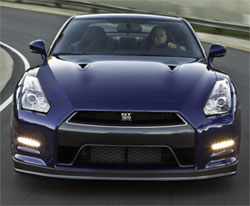 But, our favorite updates are always under the hood. Here, the GT-R's 3.8-liter twin turbo V6 gets an induction makeover, a boost in turbo pressure, and bigger exhaust. More air in, more air out...more power...530-horsepower to be exact. That's a jump of 45. Torque is up to 448 lb-ft.
But, our favorite updates are always under the hood. Here, the GT-R's 3.8-liter twin turbo V6 gets an induction makeover, a boost in turbo pressure, and bigger exhaust. More air in, more air out...more power...530-horsepower to be exact. That's a jump of 45. Torque is up to 448 lb-ft.
So, with those numbers in hand, we headed to the track in search of some numbers of our own. The GT-R blasts to 60 miles per hour in only 3.5-seconds. That's off Nissan's claim of 2.9, but it was a 95 degree day. Still, a quarter mile of just 11.9 seconds at 118 miles-per-hour is nothing to sneeze at.
The GT-R's launch mode is an experience. After engaging, there's a brief pause, and just when you're wondering what's wrong, power comes on with a whoosh and the car just takes off with you holding on for dear life. There's a fair amount of weight transfer to the rear, and the whole way down the strip you're questioning both whether the car will stay together and if you're in the right profession. Fortunately, the car holds up just fine. But, after 3 or 4 full launch mode starts, some cool down time is required.
An incredible amount of noise is present the whole time. There's all sorts of clunking and whirring coming from the rear end, while the engine itself sounds more like a kitchen appliance. Some of our staff were put off by it, others loved it.
The GT-R brings mechanical precision to handling as well. Bilstein DampTronic adjustable shocks, thick stabilizer bars, and even a carbon fiber shock tower brace helped to keep things planted through throttle-on corners.
Tweaks to stiffen the suspension setup result in even more incredibly precise steering. But, it's also very heavy; so it works you. But, there's so much grip, it's the kind of work we're up for any day.
And you can drive the GT-R every day, but not without constant reminders that you are in a serious car. At slow speeds it can feel a bit clunky, jerky, and rough, even with the suspension in its softest setting, but as you increase your pace, things do smooth out.
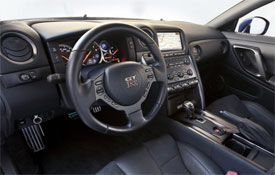 The GT-R is one sophisticated car, and there's a lot going on in the cockpit. You feel like you need a pilot's license just to operate all of the switches and keep track of all the gauges. But, beyond just looking cool, the digital gauges do give a wealth of information, and are reconfigurable to keep you updated on the data you find most helpful.
The GT-R is one sophisticated car, and there's a lot going on in the cockpit. You feel like you need a pilot's license just to operate all of the switches and keep track of all the gauges. But, beyond just looking cool, the digital gauges do give a wealth of information, and are reconfigurable to keep you updated on the data you find most helpful.
The interior itself is quite nice, and the new model year adds new carbon fiber trim. Navigation is standard, as is an 11- speaker Bose sound system.
For all of its performance, and rarity, the 2012 Nissan GT-R Premium trim base price of $90,950 is a bargain. And, Government Fuel Economy Ratings of 16-City, 23-Highway mean no gas guzzler tax.
In an automotive world that seems to require even supercars to be homogenized for daily-driving, the GT-R's rough-around-the-edges persona is a throwback. It's both Viper jagged and Corvette smooth, depending on what you ask of it. It delivers an honest-to-goodness high, and a unique driving experience from a justifiably legendary performance machine.
<A href="http://www.motorweek.org/reviews/road_tests/2012_nissan_gt_r#">
<!-- .left -->Vital Statistics
Engine: 3.8-liter twin turbo V6
Horsepower: 530
Torque: 448 lb feet
0-60mph: 3.5 seconds
1/4 mile: 11.9 seconds @ 118 mph
EPA: 16 mpg city/ 23 mpg highway
<!-- .review_box -->


 & It's only a 3.8L Engine....Would someome put a Monte Carlo Body on this 3.8L ? LOL
& It's only a 3.8L Engine....Would someome put a Monte Carlo Body on this 3.8L ? LOL<EMBED height=387 type=application/x-shockwave-flash width=638 src=http://www.youtube.com/v/eWBRfi1a8xI?fs=1&hl=en_US&rel=0&hd=1&autoplay=0 allowfullscreen="true" allowscriptaccess="always"><!-- -->
<!-- .clear -->
<!-- .video_player --><!-- -->
<!-- .clear --><!-- -->
<!-- .shadow_left_large --><!-- -->
<!-- .shadow_right_large -->
<!-- .video_player_shadow_holder --><!-- -->
<!-- .clear -->While the 2009 Nissan GT-R was actually the fifth generation of Nissan's home market Skyline supercar, it marked the first time this legendary performer made it to the U.S. And, after testing it, we felt that it more than lived up to all the hype. But no car becomes a legend by sitting still. So, for 2012, the GT-R gets a styling nip/tuck and more power. So, let's see if the legend lives on.
Some legends, like Robin Hood, are loosely based on actual people whose good deeds grow to larger-than-life through years of storytelling. Much like the Nissan GT-R. Years of video game inspired frenzy along with the sport of drifting, lofted the Nissan Skyline GT-R to its road-god status. Well, the slightly revamped 2012 Nissan GT-R continues the narrative.
Unlike the tights-wearing Robin Hood however, the GT-R looks mean with sheet metal looking aggressive, even for an exotic. Hood snorkels, flared out and vented fenders, and a huge rear wing all help to convey its serious intentions.
For 2012, there's a new front fascia with integrated LED running lights and larger air intakes. The rear fascia dons new venting and an extended carbon fiber rear diffuser, for more down force and reduced drag. New forged aluminum 20-inch wheels are both lighter and stiffer, wearing 255 Dunlop SP Sport Maxx rubber in front, 285's in the rear.
 But, our favorite updates are always under the hood. Here, the GT-R's 3.8-liter twin turbo V6 gets an induction makeover, a boost in turbo pressure, and bigger exhaust. More air in, more air out...more power...530-horsepower to be exact. That's a jump of 45. Torque is up to 448 lb-ft.
But, our favorite updates are always under the hood. Here, the GT-R's 3.8-liter twin turbo V6 gets an induction makeover, a boost in turbo pressure, and bigger exhaust. More air in, more air out...more power...530-horsepower to be exact. That's a jump of 45. Torque is up to 448 lb-ft.So, with those numbers in hand, we headed to the track in search of some numbers of our own. The GT-R blasts to 60 miles per hour in only 3.5-seconds. That's off Nissan's claim of 2.9, but it was a 95 degree day. Still, a quarter mile of just 11.9 seconds at 118 miles-per-hour is nothing to sneeze at.
The GT-R's launch mode is an experience. After engaging, there's a brief pause, and just when you're wondering what's wrong, power comes on with a whoosh and the car just takes off with you holding on for dear life. There's a fair amount of weight transfer to the rear, and the whole way down the strip you're questioning both whether the car will stay together and if you're in the right profession. Fortunately, the car holds up just fine. But, after 3 or 4 full launch mode starts, some cool down time is required.
An incredible amount of noise is present the whole time. There's all sorts of clunking and whirring coming from the rear end, while the engine itself sounds more like a kitchen appliance. Some of our staff were put off by it, others loved it.
The GT-R brings mechanical precision to handling as well. Bilstein DampTronic adjustable shocks, thick stabilizer bars, and even a carbon fiber shock tower brace helped to keep things planted through throttle-on corners.
Tweaks to stiffen the suspension setup result in even more incredibly precise steering. But, it's also very heavy; so it works you. But, there's so much grip, it's the kind of work we're up for any day.
And you can drive the GT-R every day, but not without constant reminders that you are in a serious car. At slow speeds it can feel a bit clunky, jerky, and rough, even with the suspension in its softest setting, but as you increase your pace, things do smooth out.
 The GT-R is one sophisticated car, and there's a lot going on in the cockpit. You feel like you need a pilot's license just to operate all of the switches and keep track of all the gauges. But, beyond just looking cool, the digital gauges do give a wealth of information, and are reconfigurable to keep you updated on the data you find most helpful.
The GT-R is one sophisticated car, and there's a lot going on in the cockpit. You feel like you need a pilot's license just to operate all of the switches and keep track of all the gauges. But, beyond just looking cool, the digital gauges do give a wealth of information, and are reconfigurable to keep you updated on the data you find most helpful.The interior itself is quite nice, and the new model year adds new carbon fiber trim. Navigation is standard, as is an 11- speaker Bose sound system.
For all of its performance, and rarity, the 2012 Nissan GT-R Premium trim base price of $90,950 is a bargain. And, Government Fuel Economy Ratings of 16-City, 23-Highway mean no gas guzzler tax.
In an automotive world that seems to require even supercars to be homogenized for daily-driving, the GT-R's rough-around-the-edges persona is a throwback. It's both Viper jagged and Corvette smooth, depending on what you ask of it. It delivers an honest-to-goodness high, and a unique driving experience from a justifiably legendary performance machine.
<A href="http://www.motorweek.org/reviews/road_tests/2012_nissan_gt_r#">

<!-- .left -->Vital Statistics
Engine: 3.8-liter twin turbo V6
Horsepower: 530
Torque: 448 lb feet
0-60mph: 3.5 seconds
1/4 mile: 11.9 seconds @ 118 mph
EPA: 16 mpg city/ 23 mpg highway
<!-- .review_box -->

Last edited by Space; 09-11-2011 at 09:41 AM.
Thread
Thread Starter
Forum
Replies
Last Post
Space
Off Topic
11
08-21-2012 06:43 PM
Space
Off Topic
21
07-26-2012 11:04 PM
Space
Off Topic
0
06-10-2010 06:59 AM










